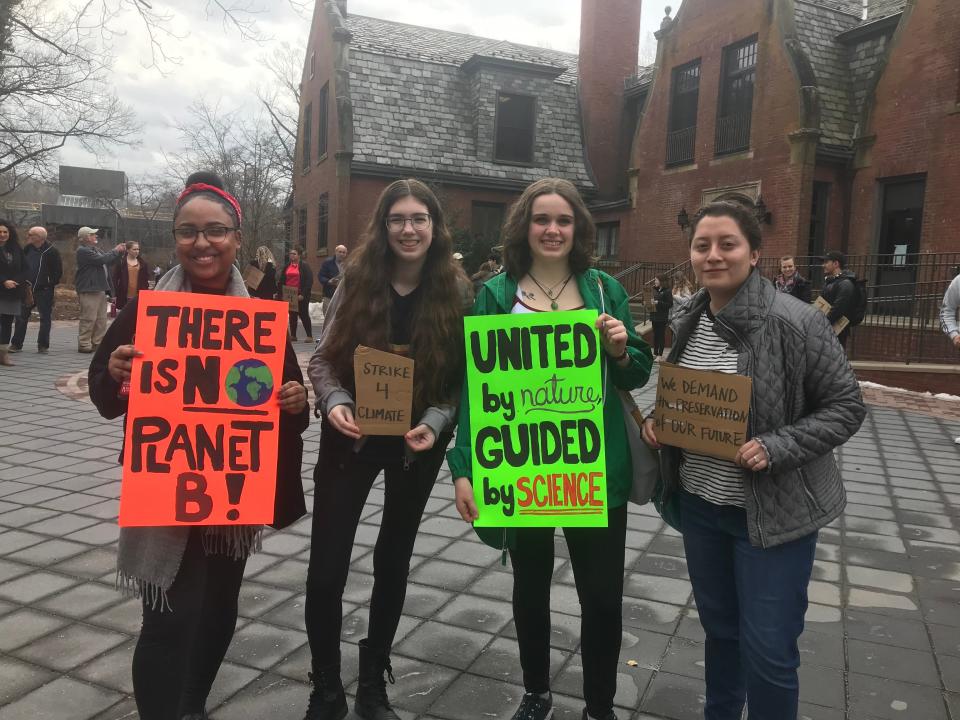Kids fearful of climate catastrophe deserve more than just walkouts | Opinion
Across the nation, young people have been walking out of school in protest.
They are protesting contaminated water in places like Flint, Michigan, and Newark, New Jersey. They are crying out against the air pollution that is causing life-threatening asthma in their classmates and the rising greenhouse gas emissions that are warming our world. And they are pushing back against the forces that target minority, indigenous, immigrant and low-income communities for highly polluting industries.
These students know that industry, development and poor government decisions are leaving them a world without clean streams, clear air, healthy ecosystems or a stable climate and they are calling out for the public and politicians to listen and act on the environmental crises that are affecting us all.
These student walkouts and other protests are having an important effect — they are raising public and political awareness of these issues. But it is important for us all to remember that while protest is valuable and empowering, it is a tool. And in order to be successful, it must lead to solutions that recognize and rectify the root cause of the problem.
What is that “root cause” that has allowed so much environmental degradation? It is a system of environmental laws that give legislators the ultimate power to decide how much pollution is acceptable. A system that focuses on legalizing and managing environmental harm through reviews and permits, rather than preventing harm in the first place. And one that has put in place a politically-determined ceiling on the level of environmental protection that can be achieved at all - a ceiling that, given the greater access that industry has to the levers of power, is unacceptably high and results in ongoing damage to our climate, environment and the health and safety of people.

But there is a remedy. Every one of us has a fundamental, natural right to clean water and air, a stable climate and a healthy environment. Recognizing these rights, and codifying them by adding Green Amendments to the Bills of Rights in our state and Federal constitutions, restores the essential power we need to protect our environment.
Simply put, a Green Amendment enshrines in the constitution the inalienable rights of all people — including both present and future generations — to pure water, clean air, a stable climate and healthy environments, and ensures these rights are protected equitably for all regardless of race, ethnicity, wealth, geography or gender.
Green Amendments are not synonymous with the more general “Environmental Rights Amendments.” They are more specific, more powerful, more transformational.
With these Green Amendments, government officials become accountable to environmental protection and climate justice, just as they are for our other fundamental freedoms. And when the government fails to provide these essential protections, Green Amendments serve as a foundation for more effective advocacy and legal challenges.
The Civil Rights era demonstrates the power that constitutional protections have when combined with effective advocacy, protest and legal action. It was not marches, sit-ins, or walk-outs alone that advanced the Civil Rights of Black Americans, but the way that non-violent protests were complemented and strengthened by strategic litigation and political action underpinned by the promise of equal protection guaranteed by the Thirteenth, Fourteenth and Fifteenth Amendments.
We see the same dynamics in the other two great challenges of our time. Despite the overwhelming public support to address gun violence in meaningful ways, the Second Amendment as currently interpreted provides a powerful argument to those who resist any limitations whatsoever on gun ownership. And the lack of an explicit constitutional protection for abortion rights allowed the U.S. Supreme Court to strip away the bodily autonomy of American women, and others with a uterus, when its political composition shifted.
The lesson here is clear: An explicit constitutional recognition of a fundamental right provides a powerful foundation for meaningful legal protections and persuasive and effective advocacy. The environmental movement is missing this constitutional protection. Green Amendments at the state level — and ultimately the federal level — provide it.
Green Amendments transform our inalienable right to a healthy environment from an unenforceable right to an enforceable constitutional reality. A new national movement, called Green Amendments For The Generation, is securing this needed constitutional reform, enshrining the right to a healthy environment in every state’s Bill of Rights, and ultimately to the federal constitution as well. It is a movement advancing in 18 states, including Pennsylvania, Montana and New York, where Green Amendments have already been secured.
The Green Amendment movement started in Pennsylvania, where the Delaware Riverkeeper Network took advantage of litigation, protest, persuasion, science and student activism to breathe life into an old and long-ignored constitutional environmental rights provision and used it to beat back an environmentally devastating pro-fracking piece of legislation. As the lead environmental plaintiff in that litigation, the victory taught me the power that a legally recognized constitutional right could provide against powerful and well-connected industries.
The recognition that we have an inalienable and constitutionally protected right to clean water and air, a stable climate, and a healthy environment transforms the way we think. The grant of constitutional protection emotionally and intellectually empowers us, raising the expectations we have of our government. It changes the protection of natural resources in government decision-making from a hope to a constitutional imperative.
Students have played a critical part of the environmental movement for as long as I’ve been a member, making powerful use of protest, non-violent direct action, political messaging and litigation to advance the causes of environmental and climate justice around the world. The Green Amendment movement is an opportunity to channel this energy into pushing history forward. Acting to secure a Green Amendment in their states will help ensure that their activism provides concrete, wide-ranging and generational environmental protection and climate justice for all. I hope you’ll join us.
To learn more or get involved: www.ForTheGenerations.org.
Maya K. van Rossum is the founder of the national Green Amendments For The Generations movement and organization, author of "The Green Amendment, The People’s Fight For a Clean, Safe & Healthy Environment" and the 30-year leader of the regional Delaware Riverkeeper Network.

This article originally appeared on NorthJersey.com: Green Amendments are a way forward on climate change

